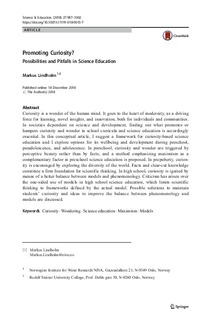| dc.description.abstract | Curiosity is a wonder of the human mind. It goes to the heart of modernity, as a driving force for learning, novel insights, and innovation, both for individuals and communities. In societies dependent on science and development, finding out what promotes or hampers curiosity and wonder in school curricula and science education is accordingly essential. In this conceptual article, I suggest a framework for curiosity-based science education and I explore options for its wellbeing and development during preschool, preadolescence, and adolescence. In preschool, curiosity and wonder are triggered by perceptive beauty rather than by facts, and a method emphasizing maximism as a complementary factor in preschool science education is proposed. In prepuberty, curiosity is encouraged by exploring the diversity of the world. Facts and clear-cut knowledge constitute a firm foundation for scientific thinking. In high school, curiosity is ignited by means of a better balance between models and phenomenology. Criticism has arisen over the one-sided use of models in high school science education, which limits scientific thinking to frameworks defined by the actual model. Possible solutions to maintain students’ curiosity and ideas to improve the balance between phenomenology and models are discussed. | nb_NO |

